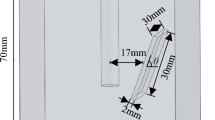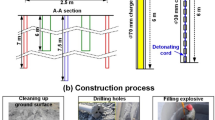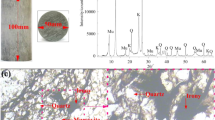Abstract
An accurate understanding of the breakage mechanism of broken coal and rock mass and its coupling relationship with stress and porosity is important for achieving efficient and safe production in coal mines, storage and utilisation of gas and water resources in goafs, and environmental ecological protection. In this study, a novel 3D simulation method is proposed for broken rock and coal granule compaction and breakage. This method can simulate the re-breakage characteristics of broken rock and coal granules during laterally confined compression (LCS). On this basis, numerical simulations combined with laboratory tests are conducted to quantitatively analyse the stress, porosity, and breakage rate evolution characteristics of broken rock granules during LCS. The entire loading process of broken rock granules is divided into three stages: self-adjustment, broken, and elastic. The stress evolution and breakage evolution characteristics of the broken rock granules during each loading stage are delineated. The breakage characteristics of broken rock granules are the main reasons for the evolution of stress, porosity, and breaking rate. In the elastic stage, only uniform compressive stress acts on the broken rock granule, inhibiting further breakage of the sample. When the loading stress reaches the tensile strength of the broken rock granules, the breakage rate of the models increases the fastest. The effects of the broken sample strength and sample size on the breakage characteristics and stress evolution law of the broken models during loading are further discussed. The secant modulus of the broken models in the elastic stages is approximately equal to the elastic modulus of the coal and rock samples. The coordination number evolution law of the broken granules during loading is the main factor affecting its breakage.























Similar content being viewed by others
References
Ai J, Chen JF, Rotter JM, Ooi JY (2011) Assessment of rolling resistance models in discrete element simulations. Powder Technol 206(3):269–282
Asadi MS, Rasouli V, Barla G (2012) A bonded particle model simulation of shear strength and asperity degradation for rough rock breakages. Rock Mech Rock Eng 45(5):649–675
Bai Q, Tu S (2019) A general review on longwall mining-induced fractures in near-face regions. Geofluids 2019:1–22
Bai Q-S, Tu S-H, Chen M, Zhang C (2016) Numerical modeling of coal wall spall in a longwall face. Int J Rock Mech Min Sci 88:242–253
Balevicius R, Kacianauskas R (2008) DEM analysis of effect of the particle size during the material flow in wedge-shaped hopper. In: The 25th international symposium on automation and robotics in construction, pp 272–278
Bauer E (2009) Hypoplastic modelling of moisture-sensitive weathered rockfill materials. Acta Geotech 4(4):261
Bolton MD, Nakata Y, Cheng YP (2008) Micro-and macro-mechanical behaviour of DEM crushable materials. Géotechnique 58(6):471–480
Cao Z, Chen J, Cai Y, Zhao L, Gu C, Wang J (2018) Long-term behavior of clay-fouled unbound granular materials subjected to cyclic loadings with different frequencies. Eng Geol 243:118–127
Chen Y, Ma G, Zhou W, Wei D, Zhao Q, Zou Y, Grasselli G (2021) An enhanced tool for probing the microscopic behavior of granular materials based on X-ray micro-CT and FDEM. Comput Geotech 132:103974
Cheng YP, Nakata Y, Bolton MD (2003) Discrete element simulation of crushable soil. Geotechnique 53(7):633–641
Cho N, Martin CD, Sego DC (2007) A clumped particle model for rock. Int J Rock Mech Min Sci 44(7):997–1010
Chu T, Yu M, Jiang D (2017) Experimental investigation on the permeability evolution of compacted broken coal. Transp Porous Media 116(2):847–868
Cil MB, Buscarnera G (2016) Dem assessment of scaling laws capturing the grain size dependence of yielding in granular soils. Granul Matter 18(3):36
Daouadji A, Hicher P-Y, Rahma A (2001) An elastoplastic model for granular materials taking into account grain breakage. Eur J Mech A Solids 20(1):113–137
Einav I (2007) Breakage mechanics—part I: theory. J Mech Phys Solids 55(6):1274–1297
Feng G, Li Z, Hu S, Zhang Y, Zhang A, Gao Q, Cui J (2018) Distribution of gob empty space for methane drainage during the longwall mining: a case study. J Nat Gas Sci Eng 60:112–124
Hagerty MM, Hite DR, Ullrich CR, Hagerty DJ (1993) One-dimensional high-pressure compression of granular media. J Geotech Eng 119(1):1–18
Hardin BO, Blandford GE (1989) Elasticity of particulate materials. J Geotech Eng 115(6):788–805
Hu S, Han D, Feng G, Zhang A, Hao G, Hu L, Li B (2020) Influence of stress on void ratios of compacted crushed rock masses in coal mine gobs. Nat Resour Res 29(2):1361–1373
Hu S, Zhang A, Feng G, Guo X, Miu X, Li C, Kang L (2018) Methane extraction from abandoned mines by surface vertical wells: a case study in China. Geofluids 201:1–9
Huillca Y, Silva M, Ovalle C, Quezada JC, Carrasco S, Villavicencio GE (2021) Modelling size effect on rock aggregates strength using a DEM bonded-cell model. Acta Geotech 16(3):699–709
Itasca Consulting Group Inc. (2014) PFC—particle flow code, Ver. 5.0. Minneapolis: Itasca
Jarrar ZA, Alshibli KA, Al-Raoush RI (2020) Three-dimensional evaluation of sand particle fracture using discrete-element method and synchrotron microcomputed tomography images. J Geotech Geoenviron Eng 146(7):6020007
Jiang H, Xu M (2014) Study of stress-path-dependent behavior of rockfills using discrete element method. Eng Mech 31(10):151–157
Jiang MJ, Yu HS, Harris D (2005) A novel discrete model for granular material incorporating rolling resistance. Comput Geotech 32(5):340–357
Laufer I (2015) Grain crushing and high-pressure oedometer tests simulated with the discrete element method. Granul Matter 17(3):389–412
Li B, Ju F (2018) An experimental investigation into the compaction characteristic of granulated gangue backfilling materials modified with binders. Environ Earth Sci 77(7):284
Li B, Liang Y, Zhang L, Zou Q (2019) Experimental investigation on compaction characteristics and permeability evolution of broken coal. Int J Rock Mech Min Sci 118:63–76
Li Y, She C (2018) Numerical simulation of effect of size on breakage strength of rockfill grains using particle flow code. Rock Soil Mech 39(8):2951–2959
Li M, Zhang J, Zhou N, Huang Y (2017) Effect of particle size on the energy evolution of broken waste rock in coal mines. Rock Mech Rock Eng 50(5):1347–1354
Liu W, Li Y, Yang C, Daemen JJ, Yang Y, Zhang G (2015) Permeability characteristics of mudstone cap rock and interlayers in bedded salt formations and tightness assessment for underground gas storage caverns. Eng Geol 193:212–223
Liu L, Yao Y, Luo T, Zhou A (2020) A constitutive model for granular materials subjected to a large stress range. Comput Geotech 120:103408
Ma ZG, Guo GL, Chen RH, Mao XB (2005) Experimental study on the compaction of water-saturated over-broken rock. Chin J Rock Mech Eng 24(7):1139–1144
Manso J, Marcelino J, Caldeira L (2018) Breakage and oedometer compression of rockfill using DEM. Comput Geotech 101:11–22
Palchik V (2003) Formation of broken zones in overburden due to longwall mining. Environ Geol 44(1):28–38
Potyondy DO, Cundall PA (2004) A bonded-particle model for rock. Int J Rock Mech Min Sci 41(8):1329–1364
Rorato R, Arroyo M, Gens A, Andò E, Viggiani G (2021) Image-based calibration of rolling resistance in discrete element models of sand. Comput Geotech 131:103929
Russell AR, Khalili N (2004) A bounding surface plasticity model for sands exhibiting particle crushing. Can Geotech J 41(6):1179–1192
Shao XQ, Chi SC, Tao Y, Zhou XX (2020) Dem simulation of the size effect on the wetting deformation of rockfill materials based on single-particle breaking tests. Comput Geotech 123:103429
Su C, Gu M, Tang X, Guo W (2012) Experiment study of compaction characteristics of broken stones from coal seam roof. Chin J Rock Mech Eng 31(1):18–26
Suescun-Florez E, Iskander M, Bless S (2020) Evolution of particle damage of sand during axial compression via arrested tests. Acta Geotech 15(1):95–112
Vivacqua V, López A, Hammond R, Ghadiri M (2019) DEM analysis of the effect of particle shape, cohesion and strain rate on powder rheometry. Powder Technol 342:653–663
Wensrich CM, Katterfeld A (2012) Rolling friction as a technique for modelling particle shape in DEM. Powder Technol 217:409–417
Whittles DN, Lowndes IS, Kingman SW, Yates C, Jobling S (2007) The stability of methane capture boreholes around a long wall coal panel. Int J Coal Geol 71(2–3):313–328
Wouterse A, Williams SR, Philipse AP (2007) Effect of particle shape on the density and microstructure of random packings. J Phys Condens Matter 19(40):406215
Xia T, Wang X, Zhou F, Kang J, Liu J, Gao F (2015) Evolution of coal self-heating processes in longwall gob areas. Int J Heat Mass Transf 86:861–868
Xiao Y, Liu H, Chen Q, Ma Q, Xiang Y, Zheng Y (2017) Particle breakage and deformation of carbonate sands with wide range of densities during compression loading process. Acta Geotech 12(5):1177–1184
Xiao Y, Wang C, Wu H, Desai SC (2021) New simple breakage index for crushable granular soils. Int J Geomech 21(8):4021136
Xiao Y, Wang C, Zhang Z, Liu H, Yin ZY (2021) Constitutive modeling for two sands under high pressure. Int J Geomech 21(5):4021042
Xiao Y, Yuan Z, Chu J, Liu H, Huang J, Luo SN, Lin J (2019) Particle breakage and energy dissipation of carbonate sands under quasi-static and dynamic compression. Acta Geotech 14(6):1741–1755
Xu M, Hong J, Song E (2017) DEM study on the effect of particle breakage on the macro- and micro-behavior of rockfill sheared along different stress paths. Comput Geotech 89:113–127
Yao Y-P, Liu L, Luo T, Tian Y, Zhang J-M (2019) Unified hardening (UH) model for clays and sands. Comput Geotech 110:326–343
Yao Y-P, Wang N-D (2014) Transformed stress method for generalizing soil constitutive models. J Eng Mech-Asce 140(3):614–629
Yavuz H (2004) An estimation method for cover pressure re-establishment distance and pressure distribution in the goaf of longwall coal mines. Int J Rock Mech Min Sci 41(2):193–205
Ye Y, Thoeni K, Zeng Y, Buzzi O, Giacomini A (2019) A novel 3D clumped particle method to simulate the complex mechanical behavior of rock. Int J Rock Mech Min Sci 120:1–16
Yin ZY, Wang P, Zhang F (2020) Effect of particle shape on the progressive failure of shield tunnel face in granular soils by coupled fdm-dem method. Tunnel Undergr Space Technol 100:103394
Yoon J (2007) Application of experimental design and optimization to PFC model calibration in uniaxial compression simulation. Int J Rock Mech Min Sci 44(6):871–889
Yu B, Chen Z, Dai Y, Xu M, Wei J (2018) Particle size distribution and energy dissipation of saturated broken sandstone under compaction. J Min Saf Eng 35(1):197–204
Zhang C, Liu J, Zhao Y, Han P, Zhang L (2020) Numerical simulation of broken coal strength influence on compaction characteristics in goaf. Nat Resour Res 29(4):2495–2511
Zhang C, Tu S, Zhang L (2017) Analysis of broken coal permeability evolution under cyclic loading and unloading conditions by the model based on the hertz contact deformation principle. Transp Porous Media 119(3):739–754
Zhang C, Tu S, Zhang L (2020) Field measurements of compaction seepage characteristics in longwall mining Goaf. Nat Resour Res 29(2):905–917
Zhang C, Tu S, Zhang L, Bai Q, Yuan Y, Wang F (2016) A methodology for determining the evolution law of gob permeability and its distributions in longwall coal mines. J Geophys Eng 13(2):181–193
Zhang C, Tu S, Zhao Y (2019) Compaction characteristics of the caving zone in a longwall goaf: a review. Environ Earth Sci 78(1):27
Zhang C, Zhang L (2019) Permeability characteristics of broken coal and rock under cyclic loading and unloading. Nat Resour Res 28(3):1055–1069
Zhang T, Zhang C, Zou J, Wang B, Song F, Yang W (2020) DEM exploration of the effect of particle shape on particle breakage in granular assemblies. Comput Geotech 122:103542
Zhang C, Zhao Y, Tu S, Hao X, Hao D, Liu J, Ren Z (2020) Influence mechanism of particle size on the compaction and breakage characteristics of broken coal mass in goaf. J China Coal Soc 45(S2):660–670
Zhao S, Zhang N, Zhou X, Zhang L (2017) Particle shape effects on fabric of granular random packing. Powder Technol 310:175–186
Zhou H, Ma G, Yuan W, Zhou W, Chang X (2017) Size effect on the breakage strengths of rock particles. Rock Soil Mech 38(8):2425–2433
Zhou D, Tian J, Liu J, Zhou C, Ning F (2018) Three-dimensional shape of rockfill material and its influence on particle breakage. Rock Soil Mech 39(10):27–32
Zhu D, Wu Y, Liu Z, Dong X, Yu J (2020) Failure mechanism and safety control strategy for laminated roof of wide-span roadway. Eng Fail Anal 111:104489
Acknowledgements
Financial support for this work was provided by the Natural Science Foundation of Beijing (8212032), the National Natural Science Foundation of China (U1910206, 52104155, 51874312, 51874278), the Research Fund of Key Laboratory of Deep Coal Resource Mining (CUMT), Ministry of Education (KLDCRM202105), and the Fundamental Research Funds for the Central Universities (2021YQNY11).
Author information
Authors and Affiliations
Corresponding authors
Ethics declarations
Conflict of interest
The author declares that there is no conflict of interest regarding the publication of this article.
Additional information
Publisher's Note
Springer Nature remains neutral with regard to jurisdictional claims in published maps and institutional affiliations.
Rights and permissions
About this article
Cite this article
Zhang, C., Zhao, Y. & Bai, Q. 3D DEM method for compaction and breakage characteristics simulation of broken rock mass in goaf. Acta Geotech. 17, 2765–2781 (2022). https://doi.org/10.1007/s11440-021-01379-3
Received:
Accepted:
Published:
Issue Date:
DOI: https://doi.org/10.1007/s11440-021-01379-3




